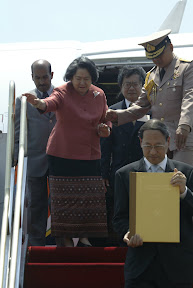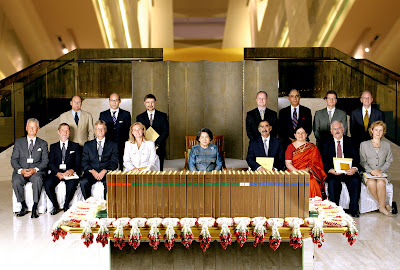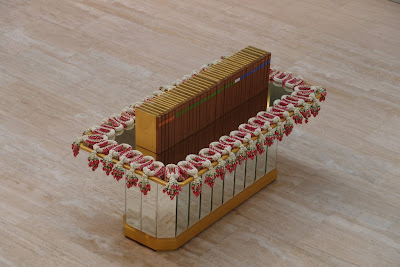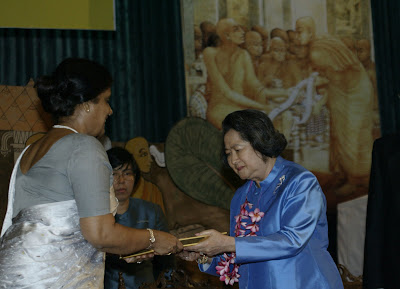Saturday June 23, 2007
It is never too late to learn more about the recent meritorious activities of His Majesty the King's only sister, Her Royal Highness Princess Galyani Vadhana Korm Luang Naradhiwas Rajanagarindra, who celebrates her 84th birthday this year. Born on May 6th in London, the princess spent her childhood in Lausanne, Switzerland, and received bachelor's degree in chemistry and education, with a major in social sciences. Quite an accomplishment for a Thai princess in those days. With the soul of a young “guru”, from Europe, she started her career as a university lecturer in Thailand, not in chemistry though, but in French and literature, in which she excelled as one of the pioneering scholars in foreign-language teaching.
Although no longer teaching, but as a staunch admirer of classical music, she continues to support art and music education in various universities nationwide.
As a member of the royal family, the princess also devotes her time to further the work of her parents, Prince and Princess Mahidol of Songkhla, particularly in preventive national health care.
Many of Princess Galyani Vadhana's medical welfare programmes have grown into well-established foundations under her patronage, such as the Princess Mother Volunteer Doctors, the Prosthesis Foundation and the Kidney Foundation of Thailand.
As the most senior member of the royal family, Princess Galyani Vadhana is the royal matriarch to all of the 130 branches of the royal lineages. One of the lesser known works, and her long-time passion, is the restoration of the forgotten royal cemetery and monastery at Wat Ratch-bophit, founded by King Chulalongkorn, the princess's grandfather.
King Chulalongkorn Chulachomklao the Great of Siam who initiated the printing of the most complete set of Pali Tipitaka and donated to the world in 1893.
King Chulalongkorn was hugely popular in Europe as the first sovereign Asian monarch to visit European capitals, over a century ago. Some of his adventurous and historic routes --a journey to the North Pole and a pilgrimage to the Holy Tooth Relic Temple in Sri lanka-- have also been traversed by the princes.
But recently, still following her grandfather's footsteps, she discovered a new and more challenging route – the King of Siam Tipitaka historic networks in 30 countries around the world.
Written on palm leaves in the sacred, old Indian language of Pali, Tipitaka has been the conventional depository of Buddha's teachings of more than 2,000 years.
In 1893, King Chulalongkorn revolutionized this traditional Buddhist convention – he published the Tipitaka in book-form for the first time. In stead of inscribing the sacred Pali texts by hand in old Khmer script, King Chulalongkorn ordered the new edition, totalling 39 volumes, to be printed in modern Siamese script by a Western printer. With the efficiency of printing teachnology and book-binding, the Siamese-script edition was sent as royal gifts to 260 institutes across five continents.
This came to light in 2003 at a commemorative public lecture on the “King of Siam's Tipitaka Technology” at the Ministry of Information and Communication Technology, presided over by Pricess Galyani Vadhana.

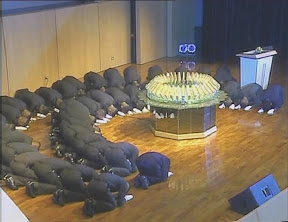

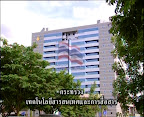

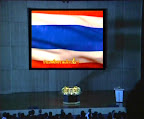


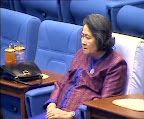
Today, only one complete set of the King of Siam Tipitaka has survived in Thailand. But a great number of these priceless collections are believed to be in existence in libraries and universities through out the world, including Uppsala University in Swenden, the Smithsonian Institute in the US. The Russian Academy in St Petersburg, the National Diet Library in Japan, the University of Sydney, Australia, and the Chinese University of Hong Kong.
King Chulalongkorn's far-sightedness to print an innovative phonetic table, such as the transliteration chart comparing the Siam-script with Roman-script alphabets, made it possible for international scholars worldwide to study the Pali text, over 100 years ago.
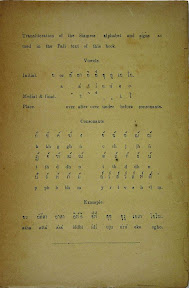
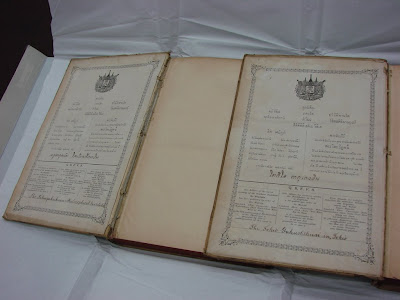
This landmark contribution by the King of Siam Tipitaka provided a solid foundation in 1957 for the Great International Council, the first ever Tipitaka convocation by 2,500 Theravada Buddhist monks in Rangoon, Burma, to celebrate 25 centuries of the Buddhist era.
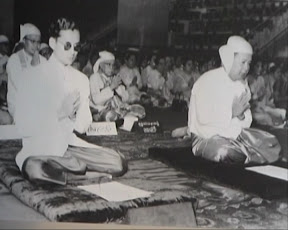
Like other heads of states,Their Majesties the King and Queen of Thailand visited the site of the Great International Council during a state visit to the Burmese capital in 1960.
In 2005, the International Council Pali Tipitaka was published for the first time by the Dhamma Society, in Roman alphabet, thereby following the tradition of Tipitaka printing initiated by the King of Siam over a century ago.
When Princess Galyani Vadhana learned about the new version, she immediately extended her support for a donation project worldwide.
Following closely in the footsteps of King Chulalongkorn, the princess accepted the position of honorary president of Tipitaka presentation to international institutes, where the King of Siam Tipitaka has been preserved.
On March 6th, 2005, the princess led a historic one-day pilgrimage to Colombo, Sri Lanka, to present the World Tipitaka Edition as a Dhamma gift to the then Sri Lankan president, Chandrika Bandaranaike Kumaratunga. Current Sri Lankan President Mahinda Rajapakse has since declared March 6th as “ World Tipitaka Day”.
published by the Dhamma Society in 2005.
Since then many international institutions have made requests to receive the World Tipitaka Edition from the princess.
This year requests came from the Maha Bhodhi Society of India, the Japan Theravada Society and Lund University of Swedan.
Presentation of the World Tipitaka Edition took place at the Ministry of Foreign Affairs on March 6th, the anniversary of the princess's inaugural presentation to the world.
Thanks to the “Princess Patron of Tipitaka”, the cultural heritage of King Chulalongkorn –the King of Siam Tipitaka– has been rediscovered. Most importantly, the wisdom of humanity in the ancient scripture has now been securely protected and preserved for prosperity.
There are two Tipitaka projects in Thailand overseen by the princess: Pali chanting at a rural temple in Nakhon Sawan; and restoration of Ayudhaya period Tipitaka Hall at Apsorn Suwan Monastery in Bangkok.
with more details and images from the World Tipitaka Project
